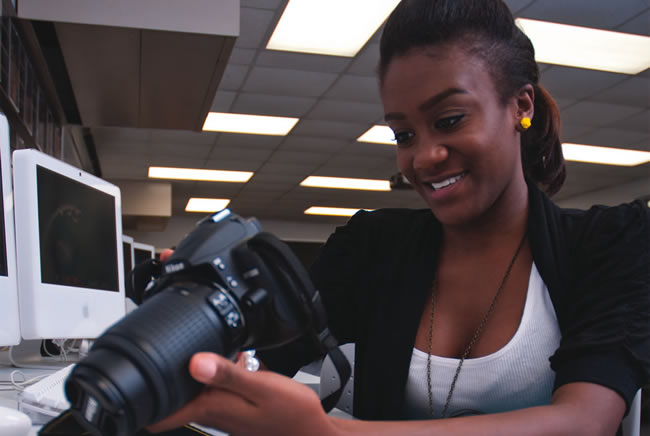Designing a Bright Future: Commercial Art at PTC
Art and design color our perception of the world—from the products we buy to the television shows we enjoy. The commercial arts play an important part in our day-to-day lives and in the business world.
“Although most people don’t consciously notice it, good design can have a huge impact on a business’s success,” says Kendall Adams, program coordinator and instructor for Piedmont Tech’s Commercial Art program.
Adams explains that, for many companies, distinctive design can make the difference between standout performance and also-ran status.

From billboards, to television ads, to the way products are packaged and manufactured: almost every element of modern consumer culture has been influenced by graphic designers and commercial art professionals at one point or another on the journey from concept to finished product. Design drives much of the way consumers perceive and interact with products.
“A Starbucks coffee cup is a great example,” says Adams. “Twenty years ago, for most people, a cup of coffee was just a commodity. One was just as good as another. But Starbucks has spent a lot of time on their branding to make sure you feel like what you’re drinking is worth an extra dollar or two—and because the experience is so well thought out, the company has been incredibly successful.”
Adams says that the development of that one cup involved a whole team of people. A graphic designer created the logo and selected the typefaces. Illustrators and photographers developed the graphics. A production artist consulted with a print technician to select the materials. And an art director oversaw the whole process to make sure the Starbucks brand was properly represented.
“And that’s just one example. Commercial art is all around us, and companies today need people who are trained to do these specialized jobs,” said Adams.
A Creative Career
If you have an artistic streak and you enjoy solving problems by thinking creatively and interacting with computers, you should consider a major in Commercial Art. As a commercial artist, you’ll plan, analyze, and create visual solutions to communications problems.
“I have some friends at other colleges and they’re not getting the same kind of exposure to Adobe Photoshop and other design software that I’ve been getting here. It’s been very useful for me to get actual, hands-on design experience.”
Commercial Art graduates are qualified to work in advertising agencies, printing companies, corporate marketing departments, and many other areas. Because there’s a bustling market for good freelance work, opportunities for self-employment are very good.
For Amy Wood, a commercial art graduate working as a professional photographer, the opportunities for self-employment were a major reason she was attracted to the program. She says, “I was always 100% determined to own my own business one day. I knew I always wanted to be creative in my career, and the Commercial Art program allowed me to learn in a hands-on approach, while giving me real-life knowledge from experienced instructors.”
According to the U.S. Bureau of Labor Statistics, the commercial arts are a high growth field. The demand for graphic designers, for example, is expected to increase by 13%, over the next decade—faster than average. For multimedia artists and animators, the outlook is even better—48%.
“This field is very competitive, but it’s really wide-open for talented people with the drive to succeed,” says Adams.
Real-World Experience
Commercial Art students get a solid foundation in design concepts, in-depth instruction in industry standard software, like the Adobe Creative Suite, Maya, and actual experience with real-world challenges related to their field of study.
For Kristin Culbreath, a second-year advertising design student who has just taken a job as a junior graphic arts specialist at Capsugel, this practical experience is one of the best parts of the program.

“I like that we get to work with actual design challenges—things like clothing design, billboards and brochures. I have some friends at other colleges and they’re not getting the same kind of exposure to Adobe Photoshop and other design software that I’ve been getting here. It’s been very useful for me to get actual, hands-on design experience,” she said.
Throughout all of the areas of study, the importance of developing a solid portfolio is stressed.
“In most hiring situations in these fields, job applicants are judged primarily on the strength of their previous work, so we spend a lot of time on helping our students develop a portfolio that’s representative of who they are as professionals,” says Adams.
Student-Centered Instruction
With 120 years of combined professional art and design experience, the Commercial Art faculty has a wealth of experience to share with students, and each instructor is focused on student success. In each class, students know at the outset how success will be measured and evaluated.
“We take student satisfaction personally, and we all make ourselves available to ensure that your academic goals are being met,” says Adams.
Classes at PTC are scheduled with students’ needs in mind, and day, evening and some online classes are available.
“I would tell anyone to definitely give Piedmont Tech a shot. It ended up being the perfect place for me because you get personal attention in class and the teachers here really work with you to get you where you want to go,” said Culbreath.
A Variety of Career Paths
Advertising Design
This certificate covers the fundamentals of copy and layout for print media advertising. In addition to core classes, course work centers around basic copywriting, advertising design, marketing and typography.
Desktop Publishing
This certificate provides training on state-of-the-art hardware using the most updated computer software programs required in the graphic design industry and includes instruction in page layout basics, scanning operations, image-editing techniques along with basic core courses.
Digital Rendering and Gaming Development
This certificate will offer training and preparation for career opportunities in entry-level positions in the fast growing digital rendering, game development and multi-media fields. Industry standard software and equipment will be used to provide exposure to digital gaming technology, game design process, animation, computer graphics and multimedia design subjects.
Photography
This certificate provides both aesthetic and commercial applications of photography. Beginning in the first semester, students will learn how to take pictures on assignment. Beginning, intermediate and advanced photography classes are offered in addition to core courses.
Illustration
This certificate provides hands-on training in the latest techniques of drawing and rendering. In addition to core courses, classes will center around basic drawing (beginning, intermediate and advanced), graphic illustration, modern art communications, color and composition.
Professional Pottery
Located in historic Edgefield County, The Professional Clay program is designed to offer a comprehensive education in the craft of pottery. Ample studio time and in-depth, one-on-one instruction will provide you with the opportunity to sharpen your skills and to develop your voice and identity as a clay artisan.